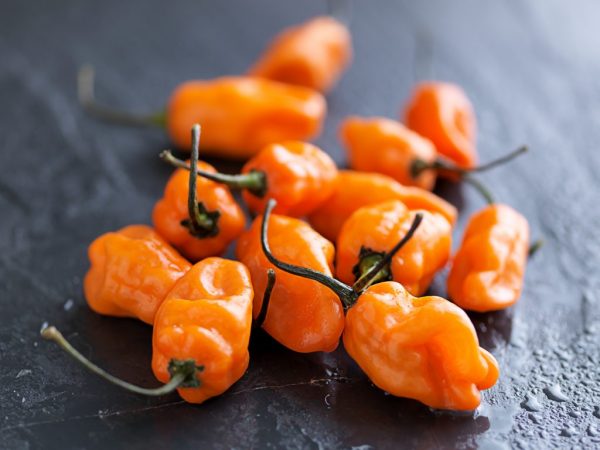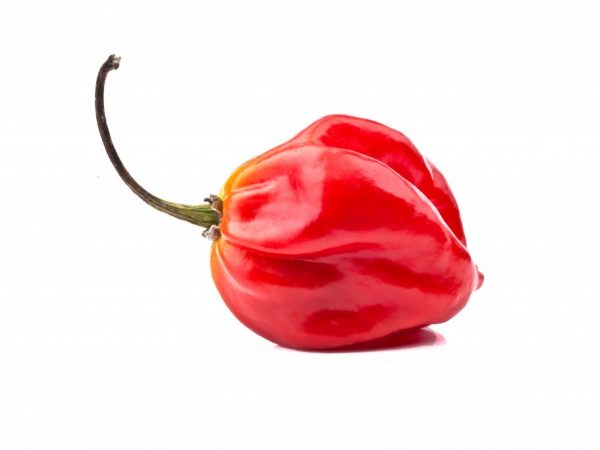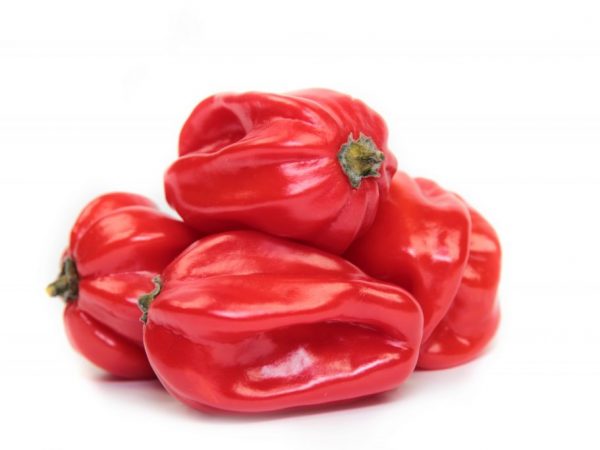Characteristics of the Habanero pepper variety
Habanero peppers are one of the most popular chili peppers. Another name is Chinese capsicum. Easily cultivated variety. It grows mainly in tropical climates, but it can be grown in our climatic conditions. Used in cooking and medicine.

Characteristics of the Habanero pepper variety
Characteristics of the variety
On the Scoville scale, the pungency of the burning plant varies from 100 thousand to 475 thousand units. Because of this, Habanero pepper is used as a condiment in Mexican cuisine.
The juice contains substances that help with pain. They also speed up hair growth.
Types of Habanero peppers:
- Habanero White. It has a white color and is the least popular due to its demanding maintenance. The shape of the fruit resembles gummies, which is why Habanero is called "candy chili". Has a very high pungency.
- Habanero Fataly. Has a pronounced peach and lemon scent. The fruits are orange or chocolate colored. On the Scoville scale, the severity ranges from 125 thousand to 325 thousand units.
- Habanero Tigerpaw. Resistant to roundworms or nematodes. The pungency is from 265 to 368 thousand units. When ripe, the fruits turn bright orange.
- Habanero Red Caribian. Has a red crop color. Most commonly used in Mexican cuisine. It is very hot. The severity is 300-475 thousand units;
- Habanero Red Savina. The fruits of this pepper are very juicy and fleshy. On the Scoville scale, the severity reaches up to 400 thousand units;
- Habanero chocolate. The color is chocolate. Has a smoky and floral aroma. The color can range from light brown to rich chocolate. The severity reaches 425 thousand units. It grows the slowest of all. It gets along best in the tropics and grows up to 120 cm. The stem is branched, the leaves are ovoid.
The Habanero pepper has a high yield. For a year, one bush gives a yield of up to 1 kg. When grown in tropical climates, it can be a perennial plant and produce crops year round. In temperate climates, it is an annual plant.
You can harvest the first fruits after 90-100 days after planting. But before that, check them for ripeness.
Fruit appearance
The fruit of the pungent Chinese capsicum resembles the shape of a heart. They have a glossy waxy surface. Unripe fruits are green in color. During ripening, they gradually acquire color according to their appearance.
Description of fruits:
- weight from 30 to 50 g;
- diameter about 2.5 cm;
- length - from 2 to 6 cm.
- floral citrus aroma.
The chocolate look has a more spherical shape and is larger in size than other types. It reaches 4 cm in diameter and 5 cm in length.
Pepper composition

Healthy and tasty peppers
Habanero contains:
- minerals (iron, phosphorus, potassium, magnesium);
- vitamins (B, B4, B9, C, K, A);
- carbohydrates;
- proteins.
The main chemical is capsaicin. When painful sensations in the body, it blocks the nerve cells responsible for sending pain impulses.
Due to the spicy aftertaste, it is not used raw.The fruits are used for conservation or dried. When preparing dishes with this vegetable, peel the seeds and pulp from the pepper.
Landing rules
Habanero pepper is a thermophilic plant. If you create favorable growing conditions, you can grow the vegetable at home.
Seeds
First, you need to soak the seeds for a few days. To do this, they are placed in gauze folded several times or between cotton napkins, which are abundantly moistened. When the seeds begin to germinate, they can be planted in the soil.
Transplanting seedlings
Better to use a small container like a pot or container. Plant seeds to a depth of 0.5 cm. Provide constant watering and the required temperature (20-25 ° C). After the first leaves appear, you can plant the seedlings in separate pots.
Seedling hardening
It is recommended to take the potted plant outdoors before planting in the ground, increasing the time each time. This will harden and the bush will be more prepared for climate change.
Care

Growing poorly on the street
Like any plant, chili requires care. If you follow these simple rules, then the capsicum will delight you with a good harvest:
- Some flowers must be cut during the flowering period. This is necessary to get large fruits.
- It is better to use compost or mineral fertilizers for feeding. If the plant lacks vitamins, the leaves on the inside will turn purple.
- Watering should be moderate. The soil should dry out between waterings. If the cultivation takes place at home, then this procedure should be carried out 2 times a day.
- To prevent aphids and mites, they are treated with a solution of laundry soap. In the early stages, you can use solutions that contain fungicides.
- If the cultivation takes place at home, then it is better to put pots with bushes on windows that face south.
- If there is not enough light and heat, then lamps can be installed for young plants.
To shape, as well as remove old inflorescences, spring pruning is carried out. For bushes that grew in a greenhouse or in a vegetable garden, it is better to carry out autumn pruning.
Pollination of plants that are planted in open ground occurs at the expense of insects. At home, you can use a soft brush.
Harvesting must be done with gloves. The fruits are bitter and after them it is difficult to wash your hands.
Diseases and pests
Improper care, insects or fungal diseases can harm the plant. Excessive watering threatens the appearance of a fungal infection of the black leg. Insufficient watering and dry soil contribute to wilting of ovaries and the appearance of aphids and spider mites.
Mite
An infusion of wood ash or insecticides will help get rid of the spider mite. Better to use organic origin. They will remove the tick, but not harm the plant itself.
Rot
The most common disease is gray mold. It is formed due to damage to the leaves or trunk. To avoid this, you should carefully and carefully harvest the crop, remove damaged leaves and petioles immediately.
Virus
Viral diseases (tobacco haze virus and cucumber virus 1) are carried by aphids. Damaged bushes must be removed. To prevent the appearance of aphids, it is necessary to monitor the condition of the soil. Check it for ants, which are the main carriers of aphids.
Nematodes
If the roots are damaged by nematodes or ringworms, the roots should be immersed in water (temperature 50-55 ° C). This water temperature will help get rid of pests, but will not damage the root system.
Conclusion
Chinese capsicum can be grown in houses on a windowsill and in a summer cottage. The main thing is to observe the temperature and light conditions during growing. It is necessary to regularly check the condition of the plant in order to prevent diseases in time. The fruit is used as a hot spice. Peppers can also be added to sauces.


